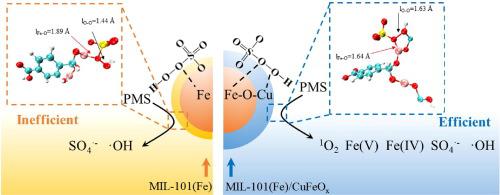Chemical Engineering Journal ( IF 13.3 ) Pub Date : 2022-08-03 , DOI: 10.1016/j.cej.2022.138461 Shiyu Zuo , Zeyu Guan , Yiming Zhang , Fan Yang , Xiaohu Li , Dongya Li

|
The scheme of coordination bridge modification provides a new vision for regulating the catalytic pathway, but how to change the surface coordination of peroxymonosulfate (PMS), thereby affecting the catalytic mechanism of PMS, is still an unknown field. In this, we found that MIL-101(Fe) is expected to control the surface catalytic pathway via the bidentate binuclear coordination configuration, thereby realizing the rapid oxidative detoxification of toxic organic pollutants and CO2 conversion. Introducing Cu on the surface of MIL-101(Fe) to change the surface chemical environment (MIL-101(Fe)/CuFeOx) can shift the catalytic pathway, thereby promoting a 14.5-fold improvement in Bisphenol A (BPA) oxidation kinetics (from 0.00697 min−1 to 0.101 min−1). Characterization, experiments, and density functional theory (DFT) results show that Cu in the vicinity of Fe can tune the electronic structure and properties of Fe-O-Cu, thereby enhancing the electron transfer rate at the active center, facilitating electronic transitions and PMS adsorption. More importantly, shifting the binding configuration of PMS from monodentate mononuclear coordination on a single Fe center to bidentate binuclear coordination on Fe/Cu centers, shorter distance coordination structures and O O pulling of PMS. The effect promoted PMS cleavage to generate more ROS and changed the catalytic pathway from the radical pathway to the 1O2 and high-valent metal species pathway. The free radical/non-radical pathway co-mediated by 1O2, high-valent metal species, ·OH and SO4·− can effectively reduce the biotoxicity of toxic organic pollutants, and can utilize alkali environment captures CO2 as a stable carbonate for environmental use. This study provides a strategy for manipulating the catalytic pathway through coordination configuration and a feasible idea for CO2 conversion in wastewater treatment.
O pulling of PMS. The effect promoted PMS cleavage to generate more ROS and changed the catalytic pathway from the radical pathway to the 1O2 and high-valent metal species pathway. The free radical/non-radical pathway co-mediated by 1O2, high-valent metal species, ·OH and SO4·− can effectively reduce the biotoxicity of toxic organic pollutants, and can utilize alkali environment captures CO2 as a stable carbonate for environmental use. This study provides a strategy for manipulating the catalytic pathway through coordination configuration and a feasible idea for CO2 conversion in wastewater treatment.
中文翻译:

通过将 CuFeOx 掺入铁基金属有机骨架中用于过氧单硫酸盐催化调控的双齿双核配位构型
配位桥修饰方案为调控催化途径提供了新的视野,但如何改变过一硫酸盐(PMS)的表面配位从而影响PMS的催化机理仍是一个未知领域。在此,我们发现MIL-101(Fe)有望通过双齿双核配位构型控制表面催化途径,从而实现有毒有机污染物的快速氧化解毒和CO 2转化。在 MIL-101(Fe) 表面引入 Cu 以改变表面化学环境 (MIL-101(Fe)/CuFeO x ) 可以改变催化途径,从而促进双酚 A (BPA) 氧化动力学提高 14.5 倍(从 0.00697 分钟-1到 0.101 分钟-1 )。表征、实验和密度泛函理论 (DFT) 结果表明,Fe 附近的 Cu 可以调节 Fe-O-Cu 的电子结构和性质,从而提高活性中心的电子转移速率,促进电子跃迁和 PMS吸附。更重要的是,将 PMS 的结合构型从单个 Fe 中心的单齿单核配位转变为 Fe/Cu 中心的双齿双核配位、更短距离的配位结构和 PMS 的 O O 牵引。该效应促进PMS裂解产生更多的ROS,并将催化途径从自由基途径改变为1 O 2和高价金属物种途径。自由基/非自由基途径共同介导1 O 2、高价金属物种·OH和SO 4 ·-能有效降低有毒有机污染物的生物毒性,并可利用碱环境捕获CO 2作为稳定的碳酸盐供环境使用。该研究提供了一种通过配位配置来操纵催化途径的策略,并为废水处理中的CO 2转化提供了可行的思路。
PMS 的 O O 牵引。该效应促进PMS裂解产生更多的ROS,并将催化途径从自由基途径改变为1 O 2和高价金属物种途径。自由基/非自由基途径共同介导1 O 2、高价金属物种·OH和SO 4 ·-能有效降低有毒有机污染物的生物毒性,并可利用碱环境捕获CO 2作为稳定的碳酸盐供环境使用。该研究提供了一种通过配位配置来操纵催化途径的策略,并为废水处理中的CO 2转化提供了可行的思路。





















































 京公网安备 11010802027423号
京公网安备 11010802027423号